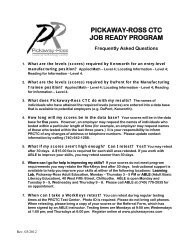Commons
Conceptual Physics - elearning-phys
Conceptual Physics - elearning-phys
- No tags were found...
Create successful ePaper yourself
Turn your PDF publications into a flip-book with our unique Google optimized e-Paper software.
aa / A New York Times headlinefrom November 10, 1919,describing the observationsdiscussed in example 13.Gravity bending light example 13Gravity is a universal attraction between things that have mass,and since the energy in a beam of light is equivalent to a somevery small amount of mass, we expect that light will be affectedby gravity, although the effect should be very small. The first experimentalconfirmation of relativity came in 1919 when stars nextto the sun during a solar eclipse were observed to have shifteda little from their ordinary position. (If there was no eclipse, theglare of the sun would prevent the stars from being observed.)Starlight had been deflected by the sun’s gravity. Figure 1.7.1 is aphotographic negative, so the circle that appears bright is actuallythe dark face of the moon, and the dark area is really the brightcorona of the sun. The stars, marked by lines above and belowthen, appeared at positions slightly different than their normalones.Black holes example 14A star with sufficiently strong gravity can prevent light from leaving.Quite a few black holes have been detected via their gravitationalforces on neighboring stars or clouds of gas and dust.Because mass and energy are like two different sides of the samecoin, we may speak of mass-energy, a single conserved quantity,found by adding up all the mass and energy, with the appropriateconversion factor: E + mc 2 .A rusting nail example 15⊲ An iron nail is left in a cup of water until it turns entirely to rust.The energy released is about 500,000 joules. In theory, would asufficiently precise scale register a change in mass? If so, howmuch?⊲ The energy will appear as heat, which will be lost to the environment.The total mass-energy of the cup, water, and iron willindeed be lessened by 500,000 joules. (If it had been perfectlyinsulated, there would have been no change, since the heat energywould have been trapped in the cup.) The speed of light inmetric units is c = 3 × 10 8 meters per second (scientific notationfor 3 followed by 8 zeroes), so converting to mass units, we havem = E c 2500, 000= ( ) 3 × 10 8 2= 0.000000000006 kilograms .(The design of the metric system is based on the meter, the kilogram,and the second. The joule is designed to fit into this system,so the result comes out in units of kilograms.) The change inmass is too small to measure with any practical technique. This is32 Chapter 1 Conservation of Mass and Energy



